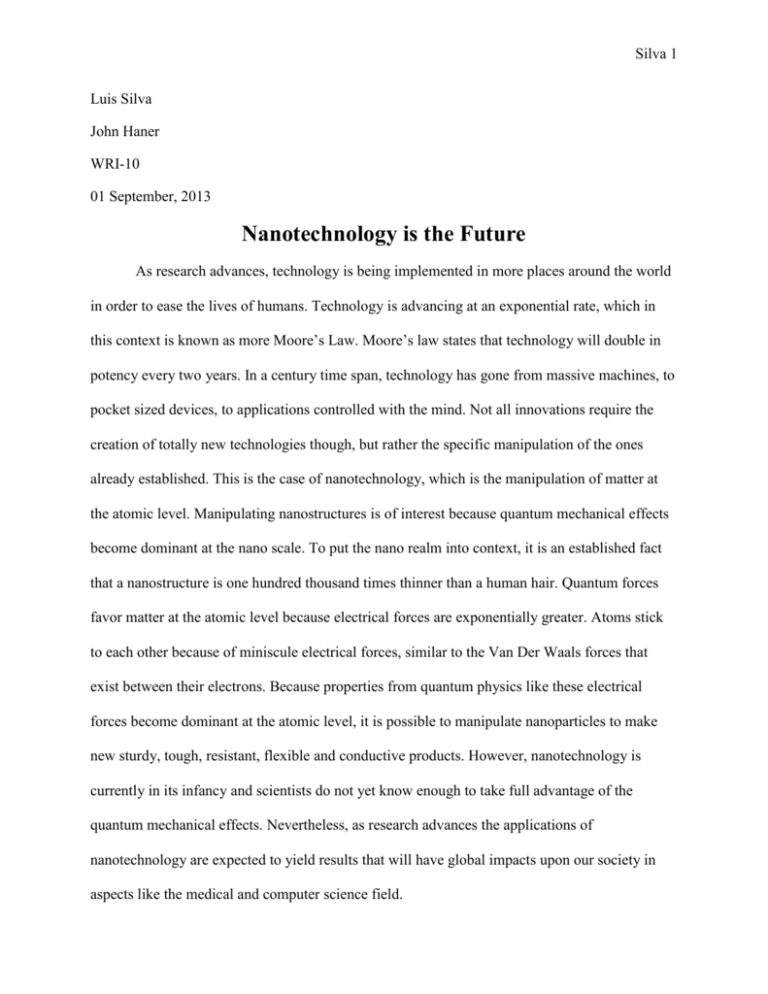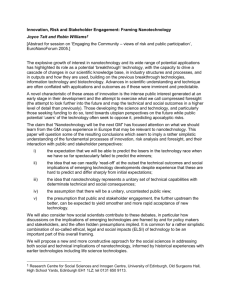Essay 2 Final - WordPress.com
advertisement

Silva 1 Luis Silva John Haner WRI-10 01 September, 2013 Nanotechnology is the Future As research advances, technology is being implemented in more places around the world in order to ease the lives of humans. Technology is advancing at an exponential rate, which in this context is known as more Moore’s Law. Moore’s law states that technology will double in potency every two years. In a century time span, technology has gone from massive machines, to pocket sized devices, to applications controlled with the mind. Not all innovations require the creation of totally new technologies though, but rather the specific manipulation of the ones already established. This is the case of nanotechnology, which is the manipulation of matter at the atomic level. Manipulating nanostructures is of interest because quantum mechanical effects become dominant at the nano scale. To put the nano realm into context, it is an established fact that a nanostructure is one hundred thousand times thinner than a human hair. Quantum forces favor matter at the atomic level because electrical forces are exponentially greater. Atoms stick to each other because of miniscule electrical forces, similar to the Van Der Waals forces that exist between their electrons. Because properties from quantum physics like these electrical forces become dominant at the atomic level, it is possible to manipulate nanoparticles to make new sturdy, tough, resistant, flexible and conductive products. However, nanotechnology is currently in its infancy and scientists do not yet know enough to take full advantage of the quantum mechanical effects. Nevertheless, as research advances the applications of nanotechnology are expected to yield results that will have global impacts upon our society in aspects like the medical and computer science field. Silva 2 Nanomachines Aiding Human Health Applications of nanotechnology in the medical science field include the engineering of a functional nanomachine designed to deliver medicine to a precise location in the body, or to navigate our bodies targeting pathogens, or to perform biopsies at the molecular level. According to the article, Nanomedicine to improve drug delivery outcomes, by the Chronicles of Young Scientists, “The current focus is to move even smaller to produce particles with diameters <500 nm” (259). With a size that is smaller than five hundred nanometers these molecular robots known as nanobots can either serve as a drug delivery system, a tiny laboratory collecting tissue samples, or can destroy detrimental cells. According to Michio Kaku, a theoretical physics professor at the City University of New York and cofounder of the string field theorem, the state of research being conducted in this medical route of nanotechnology has made these pathogen fighting nanobots a possible reality in a time span of twenty years. The nanobot will excel in precise navigation within the human body because it will be guided by using magnetism to steer it in any direction with a magnet or by “using the tails of ordinary bacteria to propel” it (Kaku 184). A medical application of nanotechnology would consist of sending a nanomachine laboratory into the bloodstream that removes any abnormalities by performing surgery without cutting the skin. For instance, the Anastasia: Essays of Researches article states that the nanobot could “open blocked arteries and treat other cardiovascular diseases” (Singh 3). Nanobots will also be able to continuously monitor the body for detrimental cells such as cancer cells by performing tiny biopsies in search for cancerous tissue. Both of these medical processes would originally require the patient to be cut open during surgery. However, nanotechnology will allow for them to be more efficient and less disturbing to the individual’s everyday life. As Wade Adams, the director of the Smalley Institute for Silva 3 Nanoscale Science and Technology at Rice University, states in his TEDxTalk presentation, once the cancerous cells are found, the nanobots can zap the cells using infrared lights as shown in Figure 1. According to Kaku, 80 percent of the cancerous cells are destroyed using this method. The nanobots will also be able to vibrate next to the cancerous cells and cause them to heat up until their Figure 1. A Creak in the Bloodstream. Photograph by Tim Fonseca http://physicaplus.org.il/zope/home/1223032001/art_de ep_en/zope/sites/physicaplus/home/en/1223032001/art _deep_en/image009.gif/qdisplay_medium.gif cell walls rupture, destroying 90 percent of the cancerous cells as reported by Kaku’s further studies. Using nanomachines to treat cancer will make chemotherapy obsolete because the nanomachines will be able to target cancerous cells and take them out without damaging healthy cells. Whereas, chemotherapy delivers deadly toxins into the body that target both healthy and cancerous cells -- killing cancerous cells faster but causing horrible side effects to the individual. The cancer killing toxins could also be delivered by nanobots that roam freely within the bloodstream. Since blood cells do not have pores, the nanobot containing the drug would simply bounce off the healthy blood cells. This is where we can use the pores cancer cells have to our advantage because they enable “macromolecules, including nanoparticles, to extravasate through these gaps into extravascular spaces and accumulate inside tumor tissues” (Acharya and Sanjeeb 5).This breakthrough in nanotechnology would make the collateral damage from chemotherapy unnecessary. Nanotechnology Making Shapeshifting A Possibility As reported by the “Programmable Matter” article, a group of researchers at Carnegie Mellon University and Intel Research Pittsburgh are jointly participating in a project called Claytronics, in which they are exploring how programmable matter will revolutionize the Silva 4 computer science field. Programmable matter consists of millions of programmable nanobot (claytronic) atoms that can self-assemble into arbitrary three dimensional shapes. With the use of software instructions one can program the claytronic atoms to shapeshift into countless objects, including but not limited to furniture, toys, tools, and a bicycle. According to Tommaso Toffoli and Norman Magolus, researchers at the Massechusetts Institution of Technology Laboratory for Computer Science, “There is the attractive possibility, in the near term, of achieving systems consisting of hundreds of billions of sites, updated a few times per second” (Toffoli and Magolus 9). Kaku agrees with this near term technology statement, as he speculates programmable matter to become a reality somewhere in the midcentury from 2030 to 2070. Figure 2 demonstrates how the claytronic atoms would link together into the whole programmable matter. Toffoli and Magolus are implying that in theory, with enough claytronic atoms, one could build entire cities at the push of a button. Figure 2. Single Nanotube. Photograph by iStock http://www.istockphoto.com/stock-photo13210950-single-nanotube.php The uppermost achievement of nanotechnology and engineering is the molecular assembler, otherwise known as the Replicator in the Star Trek television series. The Replicator is a machine that will arrive at the end of the century. It will be able to take in materials as input and manipulate them at the atomic level into any desired object. More precisely, “Trillions upon trillions of nanobots would then converge on the raw materials, each one programmed to take them apart molecule by molecule and then reassemble them into an entirely new product,” says Kaku (200). The technical names of these disintegrating and rebuilding processes are the ‘topdown’ and ‘bottom-up approach.’ According to the Fabrication of novel biomaterials through molecular self-assembly article by Shuguang Zhang, “In the 'top-down' approach, biomaterials Silva 5 are generated by stripping down a complex entity into its component parts (for example, paring a virus particle down to its capsid to form a viral cage). This contrasts with the 'bottom-up' approach, in which materials are assembled molecule by molecule (and in some cases even atom by atom) to produce novel supramolecular architectures” (Zhang 1). With these two main processes the Replicator will prove to be the pinnacle of engineering due to its effortless, quick god-like function. It is important to notice that the Replicator branches off the concept of programmable matter because you start with one object and end up with another completely different object. Yet, there is a great difference between the two nanotechnologies that should be recognized. The Replicator takes in non-programmable matter (any raw material) and the machine itself breaks the matter up into its individual atoms to rearrange them into the desired object. Whereas, the programmable matter is itself a computer made up of billions of claytronic atoms that utilizes software instructions to determine its next shape. Implications of Nanotechnology Aside from the innovative impact in the medical and computer science field, nanotechnology will have global scale implications. The programmable matter technology would replace most labor jobs. There would no longer be any need for the use of tools to build anything when instead we can use programmable matter to take the products form or the throw some old junk into the Replicator to produce it. The engineering field, however, would experience growth in careers because people will still be needed to program the software instructions the claytronic atoms and Replicator will follow. Another benefit of these nanotechnology applications is that garbage production will decline. With every single piece of matter, regardless of it being garbage Silva 6 or raw material, the Replicator will be able to disintegrate it into its most fundamental form, the atom and make it reusable. Unfortunately, the Replicator will not take care of nanowaste. Nanowaste is the waste produced from nanostructures. The current issue is that “nanomaterials have the potential to produce significant sources of nanoparticles into waterways” (Bystrzejewska-Piotrowska, Grazyna, Golimowski and Pawel 6). These nanomaterials will be extremely difficult to filter out due to their size. In addition, programmable matter and Replicator will be able to manufacture anything as long as it is provided with matter to work with while the nanobots journeying our bodies will be able to destroy cancer from within. This promising statement of course raises quite a few ethical dilemmas. For instance, who gets the privilege to use the replicator? Anything is at your fingertips with such potent technology and so great responsibility is needed. In addition, how will society work when the Replicator and programmable matter make money obsolete? Moreover, what if the nanobots get attacked by the immune system or they assault something other than cancerous cells? These ethical questions are aside from the benefits and downfalls of nanotechnology. Conclusion Nanotechnology is a promising technology that will open way into the society of the future. Although some of the applications discussed seem like they belong in another time era, they are not so distant. Again, Moore’s Law will increase the rate of nanotechnology development. The basic principles behind nanotechnology are currently being established. Fully comprehending the quantum behavior of atoms is the first step into developing these nanotechnology applications. In a few decades, thanks to Moore’s Law, nanotechnology will be everywhere; in our homes, bodies and in everything made by the Replicator, which can theoretically make anything. Silva 7 Works Cited Bystrzejewska-Piotrowska, Grazyna, Jerzy Golimowski, and Pawel L. Urban. "Nanoparticles: their potential toxicity, waste and environmental management." Waste Management 29.9 (2009): 2587-2595. Goldstein, Seth Copen, Jason D. Campbell, and Todd C. Mowry. "Programmable matter." Computer 38.6 (2005): 99-101. Kaku, Michio. Physics of the Future: How Science Will Shape Human Destiny and Our Daily Lives by the Year 2100. New York: Doubleday, 2011. Print. Misra, Ranjita, Sarbari Acharya, and Sanjeeb K. Sahoo. "Cancer nanotechnology: application of nanotechnology in cancer therapy." Drug Discovery Today 15.19 (2010): 842-850. "Nanomedicine to improve drug delivery outcomes." Chronicles of young scientists 3.4 (2012):258-. Singh S, Singh A. Current status of nanomedicine and nanosurgery. Anesth Essay Res 2013;7:237-42. TEDxTalks. “TEDxHouston 2011 – Wade Adams –Nanotechnology and Energy” Online video clip. Youtube. Youtube, 06 Aug. 2011. Web. 31 Oct. 2011. Toffoli, Tommaso, and Norman Margolus. "Programmable matter: concepts and realization." Physica D: Nonlinear Phenomena 47.1 (1991): 263-272. Silva 8 Zhang, Shuguang. "Fabrication of novel biomaterials through molecular self-assembly." Nature biotechnology 21.10 (2003): 1171-1178.



